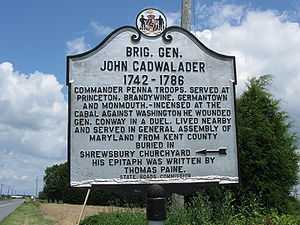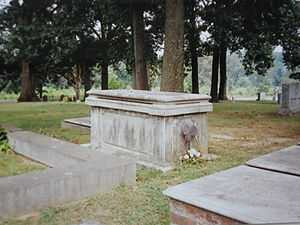John Cadwalader (general)
| John Cadwalader | |
|---|---|
 Philadelphia Museum of Art John and Elizabeth Lloyd Cadwalader and their Daughter Anne (1772) by Charles Willson Peale. | |
| Born |
January 10, 1742 Trenton, New Jersey |
| Died |
February 10, 1786 (aged 44) Kent County, Maryland |
| Occupation | Merchant |
| Spouse(s) |
Elizabeth Lloyd Williamina Bond |
| Children |
Anne, b: 1771 Elizabeth, b: 1774 Maria, b: 1776 Thomas, b: 1779 Frances, b: 1781 John, b: 1784 |
| Parents |
Thomas Cadwalader Hannah Lambert |
John Cadwalader (January 10, 1742 – February 10, 1786) was a commander of Pennsylvania troops during the American Revolutionary War.
Early life
John Cadwalader was born in Trenton, New Jersey of Quaker parentage, the eldest son of Thomas Cadwalader (1707–1779) and Hannah Lambert, his wife.[1][2] In 1750, the Cadwalader family removed to Philadelphia where John and Lambert Cadwalader, his brother, were merchants.
On September 25, 1768, John Cadwalader married Elizabeth Lloyd (1742–1776), the daughter of Edward Lloyd, of Talbot County, Maryland. Her brother, Edward Lloyd IV, was a delegate to the Continental Congress for Maryland.[3] Their daughter, Maria Cadwalader (1776–1811), married Samuel Ringgold, who became a congressman representing Maryland. Two of their sons, Samuel Ringgold and Cadwalader Ringgold, had distinguished military careers.
Revolutionary War

In 1776, Colonel John Cadwalader was elected senior officer of the Philadelphia Associators, a volunteer militia founded by Benjamin Franklin in 1747.[4] By December, Cadwalader and the Associators were positioned about 10 miles south of Trenton on the west side of the Delaware River in Bucks County, Pennsylvania at the ferry between Bristol, Pennsylvania and Burlington, New Jersey.[5] Cadwalader had received orders to send his column across the river on the night of December 25–26 and march to Trenton from the south. Meanwhile, George Washington's column would cross the river to the north of Trenton and attack the city from that direction.[6] After successfully crossing his light forces, Cadwalader discovered that river ice prevented crossing his artillery. He then returned his column to the Pennsylvania side, leaving Washington's forces unsupported in New Jersey.[7] It was fortunate for Washington that a Hessian column, having marched from their garrison at Bordentown to Mount Holly where they were engaged in the Battle of Iron Works Hill, were no longer in position to defend Trenton. Washington was successful in his surprise attack on the morning of December 26 against the Hessian garrison in Trenton.[8]
Cadwalader and his column did cross the river the next day.[9] Cadwalader subsequently took part in the further actions in New Jersey, which forced the British commander General William Howe and his principal subordinate, Lord Cornwallis, to surrender the state to the Americans.
After the Conway Cabal, he fought a duel with Thomas Conway in 1778 in which Cadwalader wounded his opponent with a shot in the mouth.
Later life

John Cadwalader married Williamina Bond (1753–1837), daughter of Dr. Phineas Bond, of Philadelphia.[10] Their son, Thomas (1779–1841), like his father, became a general of the Pennsylvania militia. Their daughter, Frances (1781–1843), married David Erskine, 2nd Baron Erskine (1777–1855), who was the British Ambassador to the United States from 1807 to 1809.
In 1779, Cadwalader became a trustee of the University of Pennsylvania and returned to his estate on the banks of the Sassafras River at Shrewsbury, Kent County, Maryland. He became a member of the Maryland State Assembly.[10]
John Cadwalader died February 10, 1786.[10][11] He is buried at Shrewsbury Chapel, Kent County, Maryland.
Thomas Paine wrote his epitaph:
His early and inflexible patriotism will endear his memory to all true friends of the American Revolution. It may with strictest justice be said of him, that he possessed a heart incapable of deceiving. His manners were formed on the nicest sense of honor and the whole tenor of his life was governed by this principle. The companions of his youth were the companions of his manhood. He never lost a friend by insincerity nor made one by deception. His domestic virtues were truly exemplary and while they served to endear the remembrances they embitter the loss of him to all his numerous friends and connexions.[2]
Furniture
John and Elizabeth Cadwalader built a city house at 2nd & Union (now Delancey) Streets in Philadelphia in 1770, and commissioned suites of furniture from cabinetmakers such as Thomas Affleck and Benjamin Randolph. Surviving pieces are among the finest and best-documented Philadelphia Chippendale furniture ever made.[12] Examples are in the Metropolitan Museum of Art, the Philadelphia Museum of Art, the Winterthur Museum, and other collections. A Cadwalader easy (wing) chair with hairy-paw feet by Affleck sold at Sotheby's New York for $2.75 million on January 31, 1987, setting a world record for the highest price ever paid for any piece of furniture at auction.[13]
Family tree
| John Cadwalader (1677–1734) | Martha Jones (1679–1747) | ||||||||||||||||||||||||||||||||||||||||||||||||||||
| Thomas Cadwalader (1708–1779) | Hannah Lambert | ||||||||||||||||||||||||||||||||||||||||||||||||||||
| Edward Lloyd (1744–1796) | Elizabeth Lloyd (1742-1776) | John Cadwalader (1742–1786) | Williamina Bond (1753–1837) | Lambert Cadwalader (1742–1823) | Mary McCall (1764–1848) | ||||||||||||||||||||||||||||||||||||||||||||||||
| Archibald McCall (1767–1843) | Elizabeth Cadwalader (1774–1824) | Samuel Ringgold (1770–1829) | Maria Cadwalader (1776-1811) | Thomas Cadwalader (1779–1841) | Thomas McCall Cadwalader (1795–1873) | Maria Charlotte Gouverneur (1801–1867) | |||||||||||||||||||||||||||||||||||||||||||||||
| George Archibald McCall (1802–1868) | Samuel Ringgold (1796–1846) | Cadwalader Ringgold (1802–1867) | John Cadwalader (1805–1879) | George Cadwalader (1806–1879) | John Lambert Cadwalader (1836–1914) | ||||||||||||||||||||||||||||||||||||||||||||||||
| George Frederic Jones (1821–1882) | Lucretia Stevens Rhinelander (1824–1901) | William Henry Rawle (1823–1889) | Mary Binney Cadwalader (1829–1861) | ||||||||||||||||||||||||||||||||||||||||||||||||||
| Edith (Jones) Wharton (1862–1937) | Frederick Rhinelander Jones (1846–1918) | Mary Cadwalader Rawle (1850–1923) | |||||||||||||||||||||||||||||||||||||||||||||||||||
| Beatrix Farrand (1872–1959) | |||||||||||||||||||||||||||||||||||||||||||||||||||||
Notes
- ↑ Historical Society of Pennsylvania
- ↑ 2.0 2.1 Kent, p. 15
- ↑ Weeks, p. 68
- ↑ Fischer, pp. 25-27
- ↑ Fischer, pp. 191, 213
- ↑ Fischer, p. 213: A detailed map of the battle plan.
- ↑ Fischer, pp. 212-215
- ↑ Fischer, pp. 229, 242
- ↑ Fischer, p. 265
- ↑ 10.0 10.1 10.2 Jordan
- ↑ Rodgers
- ↑ Nicholas B. Wainwright, Colonial Grandeur in Philadelphia: The House and Furniture of General John Cadwalader (The Historical Society of Pennsylvania, 1964).
- ↑ Lita Solis-Cohen, "Phila.-made chair sold for record $2.75 million," The Philadelphia Inquirer, February 1, 1987.
References
- Historical Society of Pennsylvania: Biography of John Cadwalader
- Fischer, David Hackett (2004). Washington's Crossing. New York: Oxford University Press. ISBN 0-19-517034-2
- Jordan, John W. (1914). Encyclopedia of Pennsylvania biography. New York: Lewis Historical Pub. Co., 111: 720-723. John Cadwalader family history
- Kent County Heritage Committee (2003). Guide to Kent County heritage. Chestertown, Maryland.
- Rodgers Biographical Dictionary. "General John Cadwallader [sic]". pp. 224–228.
- Weeks, Christopher, et al. (1984). Where land and water intertwine, an architectural history of Talbot County, Maryland. Baltimore: The Johns Hopkins University Press, ISBN 0-8018-3165-2
External links
- Biography and portrait of Gen. John Cadwalader at Virtualology.com
- Biography and portrait of Gen. John Cadwalader Courtesy of the University of Pennsylvania
- Biography and portrait of Dr. Thomas Cadwalader Courtesy of the University of Pennsylvania
- John Cadwalader (general) at Find a Grave
- The Cadwalader Family Papers, including correspondence and Revolutionary War materials belonging to General John Cadwalader, are available for research use at the Historical Society of Pennsylvania.
|